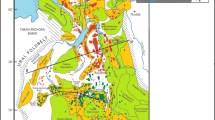Abstract
Crude oils from different basins in China, Australia and New Zealand were analyzed to character ize aromatic hydrocarbons produced in different environments by means of GC/MS. The distributions of some common compounds such as naphthalene, phenanthrene, ehrysene, pyrene, fluoranthene, fluorene, dibenzothiophene and dibenzofuran were found to be related to sedimentary environments. Especially the relative contents of fluorenes, dibenzofurans and dibenzothiophenes can be used to divide the oils into three types: (1) saline or marine carbonate environment; (2 ) fresh-brackish water lake; (3) swamp and coal-bearing sequence.
Aromatic biomarkers (e.g. retene, nor-abietene, derivatives of lupeol and β-amyrin) represent higher plant inputs with respect to the precursors of crude oils. High contents of sulphur-containing compounds like benzothiophene and dibenzothiophene series indicate a reducing sulphur-abundant diagenetic condition. The benzohopane series (C32–C35) was identified both in hypersaline and coal-bearing basins, and it is postulated to be the result of strong bacteria activity. In all the samples, a complete series of alkyl benzenes was analyzed. The similarity of its carbon-number distribution with that of n-alkanes probably suggests their genetic relationship.
The distribution of the methylphenanthrene series reflects the evolution degree of crude oils, MPI holding a positive correlation with C29-sterane 20S/(20S+20R).
Similar content being viewed by others
References
Brasseil, S.C., C. A. Lewis et al., 1986, Isoprenoid thiophenes, novel products of sediment diagenesis: Nature, v. 320, p. 160–162.
Fu Jiamo et al., 1987, Organic geochemical characteristics of sphagnum brown coal —a possible oil-generating precursor: Geochimica, n.l, p. 1–9 (in Chinese with English abstract).
Ingram, L. L. and J. Ellis, 1983, Comparative study of oil shales and shale oils from the Mahogany Zone, Green River Formation (USA) and Kerosene Greek seam, Rundle Formation (Australia): Chem. Geol., v. 38, p. 185–212.
Lalonde, R.T., 1987. Low-temperature, polysulfide reactions of conjugated ene carbonyls, a reaction model for the geologic origin of S-heterocycles: Org. Geochem., v. 11, p. 563–571.
Luo Binjie, Wang Youxiao and Yang Xinghua. 1981, Accumulation, evolution and oil-generation of terrestrial organic matter: Papers of Lanzhou Institute of Geology, Chinese Academy of Sciences, n.l, p. 1–63 (in Chinese).
Luo Binjie, Wang Guangyu, Li Xinyu and Zhang Ziyan, 1986. The discovery of benzohopane-series biomarkers and their geochemical implications: Acta Sedimentologica Sinica, v. 4, p. 125–129 (in Chinese with English abstract).
Luo Binjie, Li Xinyu. Yang Xinghua et al., 1989, General geochemical characteristics of New Zealand crude oils: Acta Sedimentologica Sinica, v. 7. p. 29–37 (in Chinese with English abstract).
Philp, R. P., 1985, Fossil fuel biomarkers, application and spectra: Amsterdam, Elsevier.
Radke, M. and D.H. Welt, 1982, Geochemical study on a well in the Western Canada Basin, relation of the aromatic distribution pattern to maturity of organic matter: Geochim. et Cosmochim. Acta, v. 46, p. 1–10.
Radke, M., H. Welt, and H. Willsch, 1986, Maturity parameters based on aromatic hydrocarbons, influence of the organic matter type: Org. Geochem., v. 10, p. 51–63.
Figby, D. et al., 1986, The synthesis of alkyl aromatic hydrocarbons and its geochemical implications: Org. Geochem., v. 9, p. 255–264.
Sheng Guoying et al., 1986, Long-chain alkylthiophenes in high-sulfur crude oils from hypersaline basins: Geochimica, n.2. p. 138–145 (in Chinese with English abstract).
Simoneit, B.R.T. et al., 1986, Cyclic terpenoids of contemporary resinous plant detritus and of fossil woods, ambers and coals, Advances in Org. Geochem., 1985: Org. Geochem., v. 10, p. 877–889.
Spyckrelle, C. H. et al., 1979, Aromatic hydrocarbon from geological sources. Part-III, A tetrahydro-chrysene derived from triterpenes in recent and old sediments: J. Chem. Res (S), 330-331 (M), p. 3746–3777.
Vassilaros, D.L., W. S. Pikin, and W. L. Sorensen, 1979, In trace organic analysis. A new frontier in analytical chemistry: NBS Spec. Publ., Washington. D.C., U.S.Government Printing Office, v.519, p. 731.
Zofla Czochanska et al., 1986, Organic geochemistry of sediments in New Zealand, Part I. A biomaker study of the petroleum seepage at the geothermal region of Waiotapu: Geochimica et Cosmochimica Acta, v. 50, p. 507–515.
Author information
Authors and Affiliations
Additional information
This project was jointly funded by the National Natural Science Foundation of China and the General Corporation of Petroleum and Natural Gases of China.
Rights and permissions
About this article
Cite this article
Binjie, L., Xinyu, L. Characteristics of aromatic hydrocarbons in crude oils. Chin. J. of Geochem. 13, 97–106 (1994). https://doi.org/10.1007/BF02838510
Issue Date:
DOI: https://doi.org/10.1007/BF02838510




